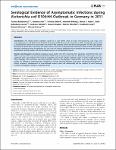Serological Evidence of Asymptomatic Infections during Escherichia coli O104:H4 Outbreak in Germany in 2011
Balabanova, Yanina
Klar, Stefanie
Deleré, Yvonne
Wilking, Hendrik
Faber, Mirko
Lassen, Sofie Gillesberg
Gilsdorf, Andreas
Dupke, Susann
Nitschke, Martin
Sayk, Friedhelm
Grunow, Roland
Krause, Gérard
Introduction: The largest known outbreak caused by a rare hybrid strain of Shiga toxin-producing E.coli (STEC) and enteroaggregative E. coli (EAEC) (E.coli O104:H4) of serotype O104:H4 occurred in Germany in 2011. Fenugreek sprouts acted as a transmission vehicle and were widely consumed in the outbreak area at the time of the epidemic. In total 3,842 people developed a clinical illness caused by this strain; however the rates of asymptomatic infections remain unclear. We aimed to develop a serological assay for detection of E.coli O104 LPS specific antibodies and to establish the post-outbreak levels of seropositivity among people with documented exposure to contaminated sprouts. Results and Discussion: Developed serological assays (ELISA with 84% sensitivity, 63% specificity and Western Blot with 100% sensitivity, 82.5% specificity) identified 33% (16/49) level of asymptomatic infection. Relatively small sample size and a significant time- lapse between the onset of symptoms and serum samples collection (appr. 8 weeks) might explain the assay variability. No association was found between clinical or demographic characteristics and assay positivity. Larger studies are needed to understand the complexity of human immune response and factors influencing development of clinical symptoms. Development of intra-outbreak research plans will substantially aid the conduct of more thorough scientific investigation during an outbreak period.
Dateien zu dieser Publikation
Keine Lizenzangabe
Verwandte Publikationen
Anzeige der Publikationen mit ähnlichem Titel, Autor, Urheber und Thema.
-
2014-03-13ZeitschriftenartikelMortality and molecular epidemiology associated with extended-spectrum β-lactamase production in Escherichia coli from bloodstream infection Leistner, Rasmus; Sakellariou, Christian; Gürntke, Stephan; Kola, Axel; Steinmetz, Ivo; Kohler, Christian; Pfeifer, Yvonne; Eller, Christoph; Gastmeier, Petra; Schwab, FrankBackground: The rate of infections due to extended-spectrum β-lactamase (ESBL)-producing Escherichia coli is growing worldwide. These infections are suspected to be related to increased mortality. We aimed to estimate the ...
-
2017-11-13ZeitschriftenartikelRisk of Transmission of Antimicrobial Resistant Escherichia coli from Commercial Broiler and Free-Range Retail Chicken in India Hussain, Arif; Shaik, Sabiha; Ranjan, Amit; Nandanwar, Nishant; Tiwari, Sumeet K.; Majid, Mohammad; Baddam, Ramani; Qureshi, Insaf A.; Semmler, Torsten; Wieler, Lothar H.; Islam, Mohammad A.; Chakravortty, Dipshikha; Ahmed, NiyazMultidrug-resistant Escherichia coli infections are a growing public health concern. This study analyzed the possibility of contamination of commercial poultry meat (broiler and free-range) with pathogenic and or multi-resistant ...
-
2014-04-10ZeitschriftenartikelResults of surveillance for infections with Shiga toxinproducing Escherichia coli (STEC) of serotype O104:H4 after the large outbreak in Germany, July to December 2011 Frank, Christina; Milde-Busch, Astrid; Werber, DirkAfter the massive outbreak of infections with Shiga toxin-producing Escherichia coli (STEC) of serotype O104:H4 in Germany in the summer of 2011, post-outbreak surveillance for further infections with this type of STEC was ...

